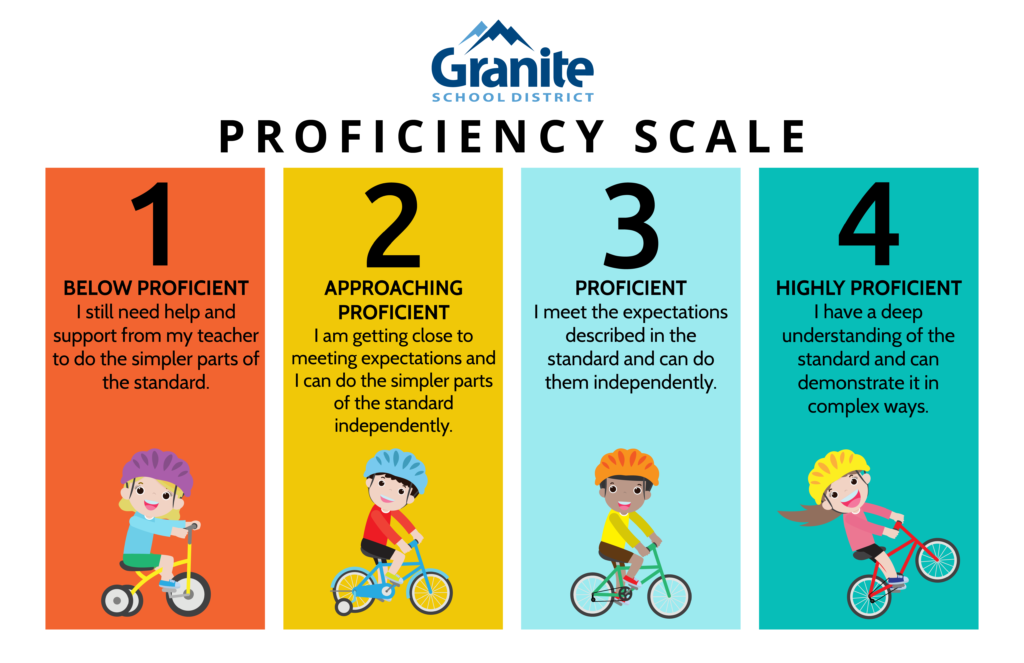The Granite District Proficiency-Based Learning model is designed around the premise that grades are intended to communicate progress to students and parents. They are intended to indicate at a prescribed moment in time what a student knows and is able to do with respect to course objectives that have been explicitly taught. They encourage the student to act on feedback and the teacher to adjust and individualize instruction.
Douglas Reeves (2008) stated, ‘If you wanted to make just one change that would immediately reduce student failure rates, then the most effective place to start would be challenging prevailing grading practices.’ The most effective grading practices provide accurate, specific, and timely feedback designed to improve student performance (Marzano, 2000, 2007; O’Connor, 2007). Rick Wormeli (2006) explained what a grade ought to be: A grade is supposed to provide an accurate, undiluted indicator of a student’s mastery of learning standards. That’s it. It is not meant to be a part of a reward, motivation, or behavioral contract system. If the grade is distorted by weaving in a student’s personal behavior, character, and work habits, it cannot be used to successfully provide feedback, document progress, or inform our instructional decisions regarding that student—the three primary reasons we grade. Unfortunately, many grades do not fit this description.
Heflebower, T., Hoegh, J. K., & Warrick, P. (2014). A school leader’s guide to standards-based grading. Bloomington, IN: Marzano Research.
Granite School District has been researching, evaluating and revising Proficiency-Based Learning since 2011. Implementation began with pilot schools in 2014 and then became district-wide in 2017. This year, 2023-2024, proficiency based learning is fully implemented K-12.
Guiding Principles
- Grades should be directly tied to specific standards and objectives in a given course or content area.
- Grades should be accurate and reflect proficiency in course standards, concepts and content.
- Grades should be associated with differences only in student performance rather than with differences in gender, ethnicity, or socioeconomic status.
- Grades should reflect multiple opportunities for assessment in multiple modalities in a given course or content area.
- Grades should be specific and timely in providing feedback to students and parents.
Reinforcing Practice
- Teachers create frequent opportunities for students to demonstrate proficiency in prescribed standards.
- Teachers utilize a multitude of assessment evidence to determine a student’s level of proficiency: assignments, observations, portfolios, assessments, products, discussions, projects, performance tasks, etc.
- “Homework” is replaced with meaningful, independent practice tied to specific content standards which requires time and effort outside the classroom. These learning activities are not scored but serve as vehicles for teacher feedback and student progress.
- Points are not deducted for reasons other than a student’s lack of academic proficiency.
- Classroom formative assessments tie directly to specific content standards and objectives.
- Teachers allow students who score below proficient on formative assessments to reassess and/or take alternative assessments to demonstrate their increased learning.
- Teachers require extra practice on specific concepts before reassessment.
- “Extra credit” is not included in the academic grade. Instead, students are given additional opportunities to demonstrate increased proficiency.
- Issues of student behavior, participation, punctuality, work timeliness and effort are reflected in a citizenship grade rather than an academic grade (unless such behaviors are written into content standards).
- Gradebook is updated regularly to prompt learning and increase proficiency.
Proficiency Levels

Highly Proficient (4): I have a deep understanding of the standard and can demonstrate it in complex ways.
Proficient (3): I meet the expectations described in the standard and can do them independently.
Approaching Proficient (2): I am getting close to meeting expectations and can do the simpler parts of the standard independently.
Below Proficient (1): I still need help and support from my teacher to do the simpler parts of the standard.

You must be logged in to post a comment.